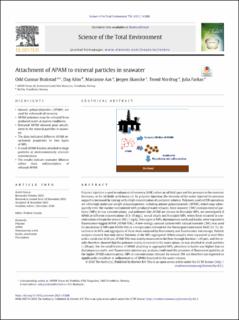Attachment of APAM to mineral particles in seawater
Peer reviewed, Journal article
Published version
Permanent lenke
https://hdl.handle.net/11250/3025271Utgivelsesdato
2021Metadata
Vis full innførselSamlinger
- Publikasjoner fra CRIStin - SINTEF Ocean [1369]
- SINTEF Ocean [1443]
Sammendrag
Polymer injection is used in enhanced oil recovery (EOR) when an oil field ages and the pressure in the reservoir decreases, or for oil fields with heavy oil. By polymer injection, the viscosity of the water injected for pressure support is increased by mixing with a high concentration of a polymer solution. Polymers used in EOR operations are often high molecular weight polyacrylamides, including anionic polyacrylamide (APAM), which may subsequently enter the marine environment with produced water releases. Since seawater (SW) contains mineral particles (MPs) in low concentrations, and polymers like APAM are known to flocculate MPs, we investigated if APAM at different concentrations (0.5–10 mg/L) would attach and flocculate MPs, when these occurred in concentrations relevant for oceanic SW (1 mg/L). Two types of MPs, diatomaceous earth and kaolin, were exposed to fluorescence-tagged APAM (APAM-TAG). A low-energy carousel system with natural seawater (SW) was used for incubation of MPs and APAM-TAG at a temperature relevant for the Norwegian Continental Shelf (13 °C). Attachment to MPs and aggregates of these were analysed by fluorometry and fluorescence microscopy. Particle analyses showed that only minor fractions of the MPs aggregated. When samples were separated in steel filter with a mesh size of 20 μm, APAM-TAG was mainly measured in the flow-through fraction (<20 μm), and the results therefore showed that the polymer mainly remained in the water-phase, or was attached to small particles (<20 μm). For the small fraction of APAM attaching to aggregated MPs, attraction to kaolin was higher than to diatomaceous earth, and fluorescence microscopy analyses confirmed the presence of fluorescent particles at the higher APAM concentrations. MPs at concentrations relevant for oceanic SW are therefore not expected to significantly contribute to sedimentation of APAM dissolved in the water column.

